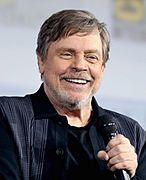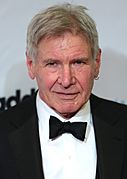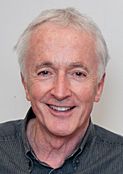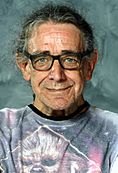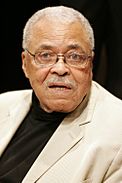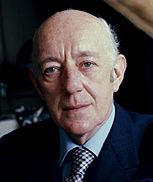Star Wars (film) facts for kids
Quick facts for kids Star Wars |
|
|---|---|
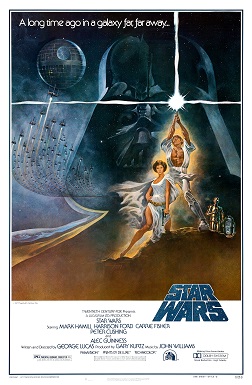
Theatrical release poster by Tom Jung
|
|
| Directed by | George Lucas |
| Produced by | Gary Kurtz |
| Written by | George Lucas |
| Starring | |
| Music by | John Williams |
| Cinematography | Gilbert Taylor |
| Editing by |
|
| Studio | Lucasfilm Ltd. |
| Distributed by | 20th Century-Fox |
| Release date(s) | May 25, 1977 |
| Running time | 121 minutes |
| Country | United States |
| Language | English |
| Budget | $11 million |
| Money made | $775.8 million |
Star Wars (retroactively retitled Star Wars: Episode IV – A New Hope) is a 1977 American epic space opera film written and directed by George Lucas, produced by Lucasfilm and distributed by 20th Century-Fox. It was the first film released in the Star Wars film series and the fourth chronological chapter of the "Skywalker Saga". Set "a long time ago" in a fictional universe where the galaxy is ruled by the tyrannical Galactic Empire, the story focuses on a group of freedom fighters known as the Rebel Alliance, who aim to destroy the Empire's newest weapon, the Death Star. When Rebel leader Princess Leia is apprehended by the Empire, Luke Skywalker acquires stolen architectural plans of the Death Star and sets out to rescue her while learning the ways of a metaphysical power known as "the Force" from Jedi Master Obi-Wan Kenobi. The cast includes Mark Hamill, Harrison Ford, Carrie Fisher, Peter Cushing, Alec Guinness, David Prowse, James Earl Jones, Anthony Daniels, Kenny Baker, and Peter Mayhew.
Often regarded as one of the greatest and most influential films ever made, the film became a pop-cultural phenomenon, launching an industry of tie-in products, including novels, comics, video games, amusement park attractions and merchandise including toys, games, and clothing. It became one of the first 25 films selected by the United States Library of Congress for preservation in the National Film Registry in 1989, while its soundtrack was added to the U.S. National Recording Registry in 2004. The Empire Strikes Back (1980) and Return of the Jedi (1983) followed Star Wars, rounding out the original Star Wars trilogy. A prequel and a sequel trilogy have since been released, in addition to two anthology films and various television series.
Contents
Plot
Amid a galactic civil war, Rebel Alliance spies have stolen plans to the tyrannical Galactic Empire's Death Star, a massive space station capable of destroying entire planets. Imperial Senator Princess Leia Organa of Alderaan, secretly one of the Rebellion's leaders, has obtained its schematics, but her ship is intercepted by an Imperial Star Destroyer under the command of the ruthless Darth Vader. Before she is captured, Leia hides the plans in the memory system of astromech droid R2-D2, who flees in an escape pod to the nearby desert planet Tatooine alongside his companion, protocol droid C-3PO.
The droids are captured by Jawa traders, who sell them to moisture farmers Owen and Beru Lars, the guardians of their nephew Luke Skywalker. While Luke is cleaning R2-D2, he discovers a holographic recording of Leia requesting help from a former ally named Obi-Wan Kenobi. Later, R2-D2 goes missing, and while searching for him, Luke is attacked by scavenging Sand People. Luke is rescued by Obi-Wan, an aged hermit. Obi-Wan tells Luke of his days as one of the Jedi Knights, former peacekeepers of the Galactic Republic, who drew mystical abilities from a metaphysical energy field known as the Force, but were hunted to near-extinction by the Empire. Luke learns that his father fought alongside Obi-Wan as a Jedi Knight during the Clone Wars until Vader, Obi-Wan's former pupil, turned to the dark side of the Force and murdered him. Obi-Wan offers Luke his father's old lightsaber, the signature weapon of the Jedi.
R2-D2 plays Leia's full message, in which she begs Obi-Wan to take the Death Star plans to Alderaan and give them to her father, a fellow veteran, for analysis. Although Luke initially declines Obi-Wan's offer to accompany him to Alderaan and learn the ways of the Force, he is left with no choice after discovering that Imperial stormtroopers have killed his aunt and uncle and destroyed their farm in their search for the droids. Traveling to a cantina in Mos Eisley to search for transport, Luke and Obi-Wan hire Han Solo, a smuggler indebted to local mobster Jabba the Hutt. Pursued by stormtroopers, Obi-Wan, Luke, R2-D2, and C-3PO flee Tatooine with Han and his Wookiee co-pilot Chewbacca on their ship, the Millennium Falcon.
Before the Falcon can reach Alderaan, Death Star commander Grand Moff Tarkin destroys the planet after interrogating Leia for the location of the Rebel Alliance's base. Upon arrival, the Falcon is captured by the Death Star's tractor beam, but the group evades capture by hiding in the ship's smuggling compartments. As Obi-Wan leaves to disable the tractor beam, Luke persuades Han and Chewbacca to help him rescue Leia after discovering that she is scheduled to be executed. After disabling the tractor beam, Obi-Wan sacrifices himself in a lightsaber duel against Vader, allowing the rest of the group to escape the Death Star with Leia. Using a tracking device, the Empire tracks the Falcon to the hidden Rebel base on Yavin IV.
The schematics reveal a hidden weakness in the Death Star's thermal exhaust port, which could allow the Rebels to trigger a chain reaction in its main reactor with a precise proton torpedo strike. Han leaves the Rebels to pay off Jabba, after collecting his reward for rescuing Leia. Luke joins their X-wing starfighter squadron in a desperate attack against the approaching Death Star. In the ensuing battle, the Rebels suffer heavy losses as Vader leads a squadron of TIE fighters against them. Han and Chewbacca unexpectedly return to aid them in the Falcon, and knock Vader's ship off course before he can shoot Luke down. Guided by the voice of Obi-Wan's spirit, Luke uses the Force to aim his torpedoes into the exhaust port, destroying the Death Star moments before it fires on the Rebel base. In a triumphant ceremony at the base, Leia awards Luke and Han medals for their heroism.
Cast
Middle: Anthony Daniels (2011), Kenny Baker (2012), Peter Mayhew (2015)
Bottom: David Prowse (2013), James Earl Jones (2013), Alec Guinness (1973)
- Mark Hamill as Luke Skywalker: A young adult raised by his aunt and uncle on Tatooine, who dreams of something more than his current life and learns about the Force and the Jedi. Lucas favored casting young actors who lacked long experience. To play Luke (then known as Luke Starkiller), Lucas sought actors who could project intelligence and integrity. While reading the script, Hamill found the dialogue to be extremely odd because of its universe-embedded concepts. He chose to simply read it sincerely, and he was cast instead of William Katt, who was subsequently cast in Brian De Palma's Carrie (Lucas shared a joint casting session with De Palma, a longtime friend). Robby Benson, Will Seltzer, Charles Martin Smith and Kurt Russell also auditioned for the role.
- Harrison Ford as Han Solo: A cynical smuggler and captain of the Millennium Falcon. Lucas initially rejected casting Ford for the role, as he "wanted new faces"; Ford had previously worked with Lucas on American Graffiti. Instead, Lucas asked Ford to assist in the auditions by reading lines with the other actors and explaining the concepts and history behind the scenes that they were reading. Lucas was eventually won over by Ford's portrayal and cast him instead of Kurt Russell, Nick Nolte, Sylvester Stallone, Bill Murray, Christopher Walken, Burt Reynolds, Jack Nicholson, James Caan, Robert De Niro, Kelsey Grammer, Al Pacino, Steve Martin, Chevy Chase, or Perry King (who later played Han Solo in the radio plays).
- Carrie Fisher as Princess Leia Organa: The princess of the planet Alderaan who is a member of the Imperial Senate and, secretly, one of the leaders of the Rebel Alliance. Many young Hollywood actresses auditioned for the role of Princess Leia, including Amy Irving, Terri Nunn, Cindy Williams, Linda Purl, Karen Allen, and Jodie Foster. Koo Stark was considered but ended up getting the role of Camie Marstrap, Luke Skywalker's friend, a character that did not make the final cut of the film. Fisher was cast under the condition that she lose 10 pounds (4.5 kg) for the role.
- Peter Cushing as Grand Moff Tarkin: The commander of the Death Star. Lucas originally offered the role to Christopher Lee but he declined. Lucas originally had Cushing in mind for the role of Obi-Wan Kenobi, but Lucas believed that "his lean features" would be better employed in the role of Tarkin instead. Lucas commended Cushing's performance, saying "[He] is a very good actor. Adored and idolized by young people and by people who go to see a certain kind of movie. I feel he will be fondly remembered for the next 350 years at least." Cushing, commenting on his role, joked: "I've often wondered what a 'Grand Moff' was. It sounds like something that flew out of a cupboard."
- Alec Guinness as Obi-Wan Kenobi: An aging Jedi Master and veteran of the Clone Wars who introduces Luke to the Force. Lucas's decision to cast "unknowns" was not taken favorably by his friend Francis Ford Coppola and the studio, so Lucas decided Obi-Wan Kenobi should be played by an established actor. Producer Gary Kurtz said, "The Alec Guinness role required a certain stability and gravitas as a character... which meant we needed a very, very strong character actor to play that part." Before Guinness was cast, Japanese actor Toshiro Mifune (who starred in many Akira Kurosawa films) was considered for the role. According to Mifune's daughter, Mika Kitagawa, her father turned down Lucas' offers to play Kenobi and Darth Vader because "he was concerned about how the film would look and that it would cheapen the image of samurai... At the time, sci-fi movies still looked quite cheap as the effects were not advanced and he had a lot of samurai pride." Guinness was one of the few cast members who believed that the film would be successful; he negotiated a deal for 2.25% of the one-fifth gross royalties paid to Lucas, which made him quite wealthy in later life. He agreed to take the part of Kenobi on the condition that he would not have to do any publicity to promote the film. Lucas credited him with inspiring the cast and crew to work harder, saying that Guinness contributed significantly to the completion of the filming. Harrison Ford said, "It was, for me, fascinating to watch Alec Guinness. He was always prepared, always professional, always very kind to the other actors. He had a very clear head about how to serve the story."
- Anthony Daniels as C-3PO: A protocol droid affiliated with the Rebellion who is "fluent in over six million forms of communication". Daniels auditioned for and was cast as C-3PO; he has said that he wanted the role after he saw a Ralph McQuarrie drawing of the character and was struck by the vulnerability in the robot's face. Initially, Lucas did not intend to use Daniels' voice for C-3PO. Thirty well-established voice actors read for the voice of the droid. According to Daniels, one of the major voice actors, believed by some sources to be Stan Freberg, recommended Daniels' voice for the role. Mel Blanc was considered for the role, but according to Daniels, Blanc told Lucas that Daniels was better for the part. Richard Dreyfuss was also considered.
- Kenny Baker as R2-D2: An astromech droid and C-3PO's companion, who is carrying the Death Star plans and a secret message for Obi-Wan from Princess Leia. When filming was under way in London, where additional casting took place, Baker, performing a musical comedy act with his acting partner Jack Purvis, learned that the film crew was looking for a small person to fit inside a robot suit and maneuver it. Baker, who was 3 feet 8 inches (1.12 m) tall, was cast immediately after meeting George Lucas. He said, "He saw me come in and said 'He'll do' because I was the smallest guy they'd seen up until then." He initially turned down the role three times, hesitant to appear in a film where his face would not be shown and hoping to continue the success of his comedy act, which had recently started to be televised. R2-D2's recognizable beeps and squeaks were made by sound designer Ben Burtt imitating "baby noises", recording this voice as it was heard on an intercom, and creating the final mix using a synthesizer.
- Peter Mayhew as Chewbacca: A Wookiee, Han Solo's sidekick, and first mate of the Millennium Falcon. Mayhew learned of a casting call for Star Wars, which was being shot in London, and decided to audition. The 7-foot-3-inch (2.21 m) tall actor was immediately cast as Chewbacca after he stood up to greet Lucas. He recounted, "I sat down on one of the sofas, waiting for George. Door opened, and George walked in with Gary behind him. So, naturally, what did I do? I'm raised in England. Soon as someone comes in through the door, I stand up. George goes 'Hmm [looked up].' Virtually turned to Gary, and said 'I think we've found him.' Mayhew originally auditioned for Darth Vader, but David Prowse was cast instead. Mayhew modeled his performance of Chewbacca after the mannerisms of animals he saw at public zoos.
- David Prowse as Darth Vader: Obi-Wan's former Jedi apprentice, who fell to the dark side of the Force. Prowse was originally offered the role of Chewbacca, but turned it down as he wanted to play the villain instead. Lucas dismissed Prowse for the character's voice due to his West Country English accent, which led to him being nicknamed "Darth Farmer" by the other cast members.
- James Earl Jones as the voice of Darth Vader; he was uncredited until 1983. Lucas originally considered for Orson Welles to voice the character after dismissing Prowse. However, Lucas was too concerned that Welles' voice would be too familiar to audiences, he instead cast then-relatively less recognizable Jones.
Other actors include Phil Brown and Shelagh Fraser as Luke's Uncle Owen and Aunt Beru; Jack Purvis, Kenny Baker's partner in his London comedy act, as the Chief Jawa in the film; and Eddie Byrne as Vanden Willard, a Rebel general. Denis Lawson and Garrick Hagon played rebel pilots Wedge Antilles and Biggs Darklighter (Luke's childhood friend), respectively. Don Henderson and Leslie Schofield appear as Imperial Generals Cassio Tagge and Moradmin Bast, respectively, and Richard LeParmentier plays Admiral Motti. Alex McCrindle portrays General Jan Dodonna, Alfie Curtis portrays Dr. Evazan, and Peter Geddis portrays Captain Raymus Antilles. Michael Leader plays a minor role as a Stormtrooper known for accidentally hitting his helmet against a door. Heavily synthesised audio recordings of John Wayne from earlier films were used as the voice of the Imperial spy Garindan. Robert Clarke appears as Imperial officer Wulff Yularen and Patrick Jordan plays another Imperial officer, Siward Cass.
Legacy and influence
Star Wars launched the careers of many of its actors, including Hamill, Ford, Fisher, Mayhew, Daniels, Baker, and Jones. Ford, who subsequently starred in the Indiana Jones series (1981–2023), Blade Runner (1982), and Witness (1985) after working on the film, told the Daily Mirror that Star Wars "boosted my career", and said, "I think the great luck of my career is that I've made these family movies which are introduced to succeeding generations of kids by their families at the time it seems appropriate."
The film also spawned the Star Wars Holiday Special, which debuted on CBS on November 17, 1978, and is often considered a failure; Lucas himself disowned it. The special has never been aired after its original broadcast, and it has never been officially released on home video. However, many bootleg copies exist, and the special has consequently become something of an underground legend.
Cinematic influence
Ebert wrote in his book The Great Movies, "Like The Birth of a Nation and Citizen Kane, Star Wars was a technical watershed that influenced many of the movies that came after." It began a new generation of special effects and high-energy motion pictures. The film was one of the first films to link genres together to invent a new, high-concept genre for filmmakers to build upon. Along with Steven Spielberg's Jaws, it shifted the film industry's focus away from personal filmmaking of the 1970s and towards fast-paced, big-budget blockbusters for younger audiences.
Filmmakers who have said to have been influenced by Star Wars include James Cameron, J. J. Abrams, Damon Lindelof, Dean Devlin, Gareth Edwards, Roland Emmerich, John Lasseter, David Fincher, Peter Jackson, Joss Whedon, Christopher Nolan, Ridley Scott, John Singleton, and Kevin Smith. Scott, Cameron, and Jackson were influenced by Lucas's concept of the "used future" (where vehicles and culture are obviously dated) and extended the concept for their films, such as Scott's science fiction films Alien (1979) and Blade Runner (1982), Cameron's acclaimed sequel Aliens (1986) and his earlier breakthrough film The Terminator (1984). Jackson used the concept for his production of The Lord of the Rings trilogy to add a sense of realism and believability. Christopher Nolan cited Star Wars as an influence when making the 2010 blockbuster film, Inception.
Some critics have blamed Star Wars, as well as Jaws, for ruining Hollywood by shifting its focus from "sophisticated" films such as The Godfather, Taxi Driver, and Annie Hall to films about spectacle and juvenile fantasy. On a late 1977 episode of Sneak Previews, Siskel expressed concern that, "It's so successful and so mindless fun that I hope Hollywood doesn't forget that there are people who like to see serious pictures too." Another critic, Peter Biskind, later complained, "When all was said and done, Lucas and Spielberg returned the 1970s audience, grown sophisticated on a diet of European and New Hollywood films, to the simplicities of the pre-1960s Golden Age of movies... They marched backward through the looking-glass." In an opposing view, Tom Shone wrote that through Star Wars and Jaws, Lucas and Spielberg "didn't betray cinema at all: they plugged it back into the grid, returning the medium to its roots as a carnival sideshow, a magic act, one big special effect", which was "a kind of rebirth."
Recognition
In its May 30, 1977, issue, Time magazine named Star Wars the "Movie of the Year". The publication said it was a "big early supporter" of the vision which would become Star Wars. In an article intended for the cover of the issue, Time's Gerald Clarke wrote that Star Wars is "a grand and glorious film that may well be the smash hit of 1977, and certainly is the best movie of the year so far. The result is a remarkable confection: a subliminal history of the movies, wrapped in a riveting tale of suspense and adventure, ornamented with some of the most ingenious special effects ever contrived for film." Each of the subsequent films of the Star Wars saga has appeared on the magazine's cover.
Star Wars was voted the second most popular film by Americans in a 2008 nationwide poll conducted by the market research firm, Harris Interactive. Star Wars has also been featured in several high-profile audience polls: in 1997, it ranked as the 10th Greatest American Film on the Los Angeles Daily News Readers' Poll; in 2002, the film and its sequel The Empire Strikes Back were voted as the greatest films ever made in Channel 4's 100 Greatest Films poll; in 2011, it ranked as Best Sci-Fi Film on Best in Film: The Greatest Movies of Our Time, a primetime special aired by ABC that counted down the best films as chosen by fans, based on results of a poll conducted by ABC and People magazine; in 2014 the film placed 11th in a poll undertaken by The Hollywood Reporter, which balloted every studio, agency, publicity firm, and production house in the Hollywood region.
Reputable publications also have included Star Wars in their best films lists: in 2008, Empire magazine ranked Star Wars at No. 22 on its list of the "500 Greatest Movies of All Time"; in 2010, the film ranked among the "All-Time 100" list of the greatest films as chosen by Time magazine film critic Richard Schickel; the film was also placed on a similar list created by The New York Times, "The New York Times Guide to the Best 1,000 Movies Ever Made"; in 2012, the film was included in Sight & Sound's prestigious decennial critics poll "Critics' Top 250 Films", ranking at 171st on the list, and in their directors poll at 224th.
Lucas's original screenplay was selected by the Writers Guild of America as the 68th greatest of all time. In 1989, the United States Library of Congress named Star Wars among its first selections to the National Film Registry as being "culturally, historically, or aesthetically significant"; at the time, it was the most recent film to be selected and it was the only film from the 1970s to be chosen. Although Lucas declined to provide the Library with a workable copy of the original film upon request (instead offering the Special Edition), a viewable scan was made of the original copyright deposit print. In 1991, Star Wars was one of the first 25 films inducted into the Producers Guild of America's Hall of Fame for setting "an enduring standard for American entertainment." The soundtrack was added to the United States National Recording Registry 15 years later (in 2004). The lack of a commercially available version of the 1977 original theatrical edit of the film since early '80s VHS releases has spawned numerous restorations by disgruntled fans over the years, such as Harmy's Despecialized Edition.
In addition to the film's multiple awards and nominations, Star Wars has also been recognized by the American Film Institute on several of its lists. The film ranks first on 100 Years of Film Scores, second on Top 10 Sci-Fi Films, 15th on 100 Years...100 Movies (ranked 13th on the updated 10th anniversary edition), 27th on 100 Years...100 Thrills, and 39th on 100 Years...100 Cheers. In addition, the quote "May the Force be with you" is ranked eighth on 100 Years...100 Movie Quotes, and Han Solo and Obi-Wan Kenobi are ranked as the 14th and 37th greatest heroes respectively on 100 Years...100 Heroes & Villains.
Adaptations, sequels, and prequels
A radio drama adaptation of the film was broadcast on the American National Public Radio network in 1981. The adaptation was written by Brian Daley and directed by John Madden, and was produced with cooperation from George Lucas, who donated the rights to NPR. Williams's music and Burtt's sound design were retained for the show, and Hamill and Daniels reprised their roles. The radio drama narrative began with a version of the backstory to the film, which relates Princess Leia's acquisition of the secret Death Star plans. It also featured scenes not seen in the final cut of the film, such as Luke Skywalker's observation of the space battle above Tatooine through binoculars, a skyhopper race, and Vader's interrogation of Princess Leia. The radio version was originally considered to be part of the official Star Wars canon, but has since been supplanted by revised canonical narratives.
Star Wars was followed by The Empire Strikes Back in 1980 and Return of the Jedi in 1983, which concludes the original film trilogy. The Empire Strikes Back and Return of the Jedi continue the backstory of the original trilogy. Like the previous film, The Empire Strikes Back and Return of the Jedi were a financial success and fared well with critics, as the original trilogy is considered one of the best film trilogies in history.
22 years after the release of Star Wars, Lucas wrote and directed the prequel trilogy, consisting of the films The Phantom Menace (1999), Attack of the Clones (2002), and Revenge of the Sith (2005). The films chronicle the history between Obi-Wan Kenobi and Anakin Skywalker, and the latter's fall to the dark side and transformation into Darth Vader. The prequel trilogy was financially successful, and polarized critics and fans on their release for the storylines and some new characters. After Lucas sold the Star Wars franchise to The Walt Disney Company in 2012, Disney developed a sequel trilogy, consisting of The Force Awakens (2015), The Last Jedi (2017), and The Rise of Skywalker (2019). Original trilogy cast including Ford, Hamill, and Fisher reprised their roles, alongside new characters portrayed by Daisy Ridley, John Boyega, Adam Driver, and Oscar Isaac. Standalone films and television series have also been released, exploring adventures set around the main trilogy arcs.
See also
 In Spanish: Star Wars: Episodio IV - Una nueva esperanza para niños
In Spanish: Star Wars: Episodio IV - Una nueva esperanza para niños



